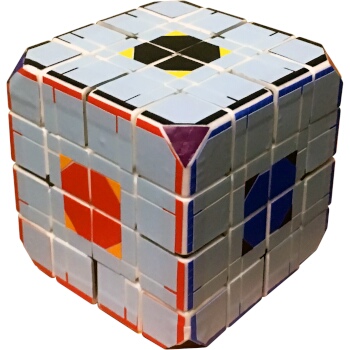
Above:View 1
Click a thumbnail to see its larger version and description.
This puzzle is all about thinking.
Ilya Toporgilka drew:
1)All face turning truncated cubes bigger than 1 are 4x4x4s
2)Shape mods like octrignis made from odd layered cubes approach the truncated cube
3)The last puzzles are all 4x4x4s
"What other puzzles can I also combine there?"
"If a 4x4x4 has internal edges, can it then also be a crazy puzzle like a 2x3x3 or a 2x2x2?"
"Does that mean that I can "insert" a ball in a cube puzzle?"
Ilya Toporgilka had been thinking about this for 1,5 months all days and nights!
A crazy 2x2x2, as he noticed, has an "initial mistake". The circles DO NOT show anything from the internal hidden centers. This meant that the other even layered cubes while being crazy have to just show the coloured hidden edges. These can be coloured internally and 4 centers each side have a drawn circle. Ilya Toporgilka also noticed a crazy 2x3x3 did not have an outer center shown. The internal 1x1x1 block replaced the outer center completely.
As crazy planetary 2x2x2s had come out, they had the same puzzle as the crazy 2x2x2("different looking" fused cube) as the Neptune version. The explanation of this choice is that the crazy Neptune from the 3x3x3 planets had 3 adjacent fixed sides. This helped Ilya Toporgilka to come up with how to make a 4x4x4 planet. At least, Neptune. This mod does not require any piece being modified. To achieve 12 internal 4x4x4 edges have to be stickered and each 2x2 center has to have a circle drawn on it. Ilya Toporgilka could not believe it but he had been able to actually make a crazy Neptune truncated cube with 24 layers!
In order to hide the disproportionality on a puzzle where a 1x1x1 is inside a 2x2x2 which is inside a 3x3x3, each side has to be at least 12x12 square. It coincides with the 2x2x2 with a 1x1x1 inside made from a 3x3x3 which also has 12x12 sides. A ball inside has visible 4x4 squares. The next overlapping cube has the next ball which has 2x2 visible sides. Previously it was recognized that a 1x1x1 ball has 4x4 visible squares. It means a ball with 2x2 visible sides has to have 1 "cubie" 4x4 square each. It brings 1/3 being an 8x8 square. A 4x4x4 where each piece is split into 6x6 squares. So, each triangle on this truncated cube(multilayered) is a pattern as it was on a FTO.
The hardest was to think how the "engineering nets" would present themselves. How to "insert" a crazy aspect. Remembering how the "crazyness" of a 2x3x3 took its center piece's place, Ilya Toporgilka left the void where 22x22 squares are. There is a "white-grey-cupurous" colour for the void. Within that void he put crazy circles which are 1/3 of a 4x4x4. The segments which finish a 1/3 square also display the internal ball in a cube. To highlight that ball opposite sticker colours have been used for those segments.
Everything with stickers with stickers coincidentally worked out! A 1/3 square within the void not only shows the crazyness and the internall ball in a cube, but also shows that this is a 3x3x3 overlapping cube made from a 4x4x4. The wrinkles within the void stickers show that this overlapping 3x3x3 has a 2x2x2 inside which also has a 1x1x1, which these stickers replace and hide at the start. The void stickers which took place of an overlapping at first compensate that and bring the "duty"(like credit) back. There are 2 versions of proportional overlapping cubes. Either each puzzle coincide with a cubie size but located underneath or...each puzzle has proportional cubies but a cubie of a "smaller" puzzle is bigger, however, the edge of each puzzle coincides. These 2 versions cannot be made simultaneously on one puzzle. The stickers of the void display some squares on each side:
9 squares of a 3x3x3, each is the same
4 squares of a 2x2x2, each is the same. The size of each square is a half of an edge length of 3 "bigger" squares. Because of this the edge lengths match.
1 "big" square. The "biggest" square. It is a bound of a 3x3.
(Also there are squares which is a "combination" so there are more than 14 squares on each side.)
Ilya Toporgilka reminded that there are also stickers on the internal 4x4x4 edges in case the reader had forgotten.
Ilya Toporgilka didn't forget to mention that he had got an idea and inspiration from Tony Fisher's overlapping cube and ball in a cube puzzles.
Links

Contributors
No one has contributed to this page yet!
Collections
No one has added this puzzle to a collection yet!
Found a mistake or something missing?
Edit it yourself or
contact the moderator.



